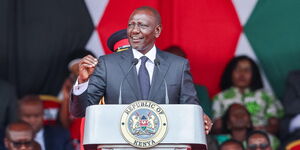The Kenyan shilling has maintained an exchange rate of approximately Ksh129 per US dollar since August, a stability that has sparked fresh debate on the broader economic impact on households and businesses.
Treasury Principal Secretary Chris Kiptoo has suggested that, were it not for the Central Bank of Kenya (CBK) actively buying dollars, the currency could be trading as low as Ksh100 to the greenback.
Speaking at an economic forum on Thursday, Kiptoo highlighted the CBK's intervention as a key factor in preventing the shilling from appreciating too rapidly. “In fact, the Central Bank has been buying dollars over the same period. You can imagine if it was not going to the market to buy, what would have happened? The shilling would have been even stronger, perhaps around Ksh100,” Kiptoo stated.
The sustained strength of the shilling, however, has raised eyebrows among economists, with some questioning how the government has managed to keep the exchange rate stable for nearly half a year. “If you look at the Kenyan shilling over the last eight, nine months, it has been very stable in the 128 to 130 range, and I don’t know what magic is keeping it there,” Kwame Owino, an economic expert, remarked.
One of the key concerns among experts is that the shilling’s strength might be artificially maintained, impacting export competitiveness. “Over the same period, the US dollar has appreciated against other global currencies. What this means is that the Kenyan shilling has actually strengthened by another 10 percentage points. It is far too strong for export competitiveness and tourism,” Owino explained.
While a strong shilling generally translates to cheaper imports, economists argue that its benefits have not trickled down to the average Kenyan. Kwame noted that despite the government’s insistence that inflation is under control, many Kenyans continue to struggle with the high cost of living.
According to Owino, the decline in inflation—currently at 3.3 per cent in January from 3 per cent in December 2024—has not been enough to offset years of price hikes. “People are poorer today than they were during the COVID-19 era. Pay slips have not increased in proportion to past price surges, leaving households struggling,” he said.
Although staple food prices, including maize flour, have recorded some reductions, the overall decrease is not proportional to previous years’ sharp increases he explained. Owino pointed out that the primary reason inflation has remained low is not necessarily that prices have dropped but that demand is weak due to stagnant wages.
“The drop could not be, in my assessment, because prices have significantly fallen. It's because demand is weak. People don’t have income, wages have not been rising. That’s why we are seeing these numbers,” said Owino, the CEO of the Institute of Economic Affairs (IEA-Kenya).
Carol Kariuki, CEO of the Kenya Private Sector Alliance (KEPSA), echoed similar sentiments. “The prices might seem like they are going down, but it is because people don’t have money, yet businesses are still producing,” she said. This, she argued, paints a distorted picture of economic improvement.
A stronger shilling typically makes imports cheaper, which could benefit consumers. However, its impact on local industries that rely on exports could be detrimental, potentially slowing economic growth and job creation. Businesses operating in the global market may struggle to remain competitive, as their goods and services become relatively more expensive for foreign buyers.
Additionally, the continued high cost of living suggests that any relief from a stronger currency is being offset by deeper economic issues. While inflation remains below 5%, the residual effects of years of price increases, coupled with stagnant wages, have made financial recovery difficult for many households.
The government remains optimistic that stability in the exchange rate will ultimately translate into economic gains. However, with wages lagging behind and demand remaining weak, the tangible benefits for most Kenyans remain elusive.












